Reawakening kings’ land
To bring back the glory of Rajarata...:
By Dhaneshi Yatawara
[email protected]
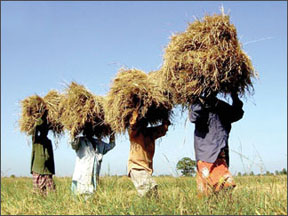
Harvesting in the paddy fields of Anuradhapura |
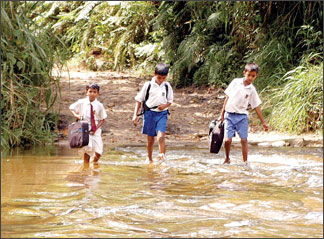 |
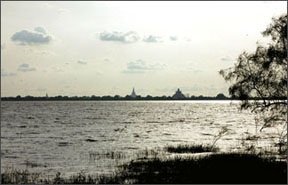 |
|

Sunset at Parakrama Samudra
|
Sri Lankan kings’ land, or the ‘Rajarata’ hails to a pride history
contributing to an enormous portion of the country’s history. It is the
birth place of our hydraulic civilization where our ancestors were the
world’s wonderful makers of reservoirs, stupas and astounding
architectural creations.
As history shows the country’s development showed declining signs
with the loss of this marvellous culture and land. Rajarata or the North
Central Province is an area with rich cultural heritage.
The region is still lagging behind in using its full potential to
contribute to the national economy and developing capacity to absorb
benefits of mainstream development of the country.
Developing the North Central Province is aimed at bridging this gap
through infrastructure and institutional development programs. The
strategy for Rajarata reawakening is centred on self-sustained villages
and the preservation of culture and heritage.
Developing the two districts, Anuradhapura and Polonnaruwa seems to
be taking two mainstreams. A self-sustained village development and the
development of religious and cultural places.
It has been observed that the flow of water resources is
comparatively less for provinces like North Central than other provinces
like Western, Southern, Central and North Western. As a result, the
level of growth of economy, education, health and infrastructure
facilities of these provinces have been deteriorating over the years.
Therefore the present Government initiated special projects to uplift
the ancient Rajarata with a prime objective of developing the province
by implementing accelerated infrastructure and livelihood development
programs uplifting the living standards of the people in every sector of
the province.
At present these projects are being implemented under the purview of
the Ministry of Nation Building and Estate Infrastructure Development.
Projects are being implemented under the Gama Neguma development program
as per the Mahinda Chinthana - the vision for tomorrow.
Rural development
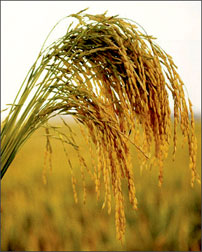 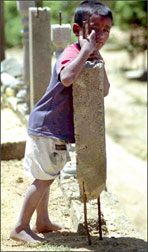 Gama Neguma is the major rural development program of the national
development plan. From ancient times, we have been a land of village
communities. Even now large majority of population live in the rural
areas. Hence, any development initiative should be given due recognition
to this reality, if it is to be successful. Gama Neguma is the major rural development program of the national
development plan. From ancient times, we have been a land of village
communities. Even now large majority of population live in the rural
areas. Hence, any development initiative should be given due recognition
to this reality, if it is to be successful.
The Government believes that our village, while retaining its
strengths and impressive features, can be developed as a micro centre of
growth with the vision that village has to be a decent and comfortable
place for people to live, work and engage in their cultural and communal
activities.
The key policy objective of the Government with regard to rural
development is to develop all villages of the country so that they
emerge as micro centres of growth on modern lines.
Gama Neguma will be the main village uplift program bringing together
a number of other specific programs focused on livelihood development
and poverty reduction at village level.
At present there are two main channels for delivering Government
programs to the village - one is the decentralized system comprising the
District Secretariats, Divisional Secretariats and the Grama Niladhari
Divisions. The other one will be the devolved system which comprises the
Provincial Council and the Local Government Authorities - particularly
the Pradeshiya Sabhas.
The Reawakening
In this backdrop the Government emphasizes advancement of villages in
the Anuradhapura and Polonnaruwa districts and minimizing the
disparities in socio, economic, infrastructure sectors in the region for
the development of the North Central Province.
Drinking water schemes, upgrading of rural roads, health sector
development, rural electrification projects and social, educational and
cultural infrastructure improvements can be highlighted as the main
components of the initiated and planned projects.
|
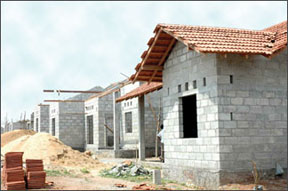
A housing scheme under construction |
“The basic development unit is the grama niladhari divisions and the
North Central Province holds 2824 GN divisions,” P. V. Gunathilake,
Senior Assistant Secretary of the Ministry told us explaining the
process. Under the Ministry of Nation Building and Estate Infrastructure
Development, the North Central Province comes under ‘Zone 3’. (The
Ministry has divided the country into six zones.) Accordingly the budget
allocations for this year were directed to the zones and not to the
Ministry.
“The total allocation for this year was 14,400 million rupees and out
of which 2700 million rupees was for the Zone 3,” Mr. Gunathilake added.
Janasabha
The concept of setting up of ‘Janasabha’ societies is unique under
the Gama Neguma program. The main objective is to fill the vacuum of not
having one single place where the services of village level officers
could be obtained or as a meeting place for the people to gather and
arrive at decisions on common matters.
The officers of the Janasabha comprises the Grama Niladhari, Samurdhi
Officer, Agriculture Research and Production Assistant, midwife and the
Police officer in the Citizens’ Committee of the respective village.
Everyone in the village is a memeber.
Considering the views of all the members of this society the
Janasabha drafts the Village Development plan. People of the village
gets the chance of deciding what should be built first or which road
should be repaired first.
“The officers of the Janasabha act solely as facilitators. All the
villagers are making the final decision as to how their village should
be developed,” Mr. Gunathilake added.
The Government’s village uplift programs strongly focus on community
participation in preparing intergrated village development plans
targetting all development efforts to achieve a common objective.
This gives an opportunity for an average villager, mostly our
farmers, to directly and actively participate in their economic, social,
cultural and moral development efforts. This empowers the village
community to ensure their total commitment and contribution in the
development process. This concept pools all resources utilized in
village development. Thus, a productive, transparent intergrated
development plan is implemented.
The ‘Janasabha’ concept transforms the rural community to a group of
development activists with ideological and comparative thinking
abilities and enhance self determination by developing their abilities
and skills. A sustainable development on self reliance.
Some of the villages in the Polonnaruwa district are located close to
terrorist threatened villages and often attacked by the Tiger
terrorists.
Development
|
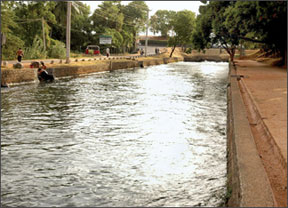
At Polonnaruwa |
The overall development can be classified as, infrastructure
facilities development, developing common amenities, developing rural
livelihood and religious, cultural and spiritual development.
In the Anuradhapura district, in all the Divisional Secretariat
divisions, projects on developing roads, bridges and culverts, water
supply, agriculture, irrigation, education, electricity, sports and many
others are in progress.
There are 89 projects for the development of roads, bridges and
culverts. 64 projects are implemented in every DS division to uplift the
water supply and sanitation. And 82 projects are on process building
houses, community halls, market places etc. Fifty projects are
implemented in the district to provide electricity for the most rural
areas.
In the Polonnaruwa district 171 projects are on process or some will
be initiated shortly, to develop and reconstruct roads, bridges and
culverts. 17 projects are implemented to provide safe drinking water for
the people. 21 projects are in line to develop the irrigation system
throughout the district. 45 projects to develop the education sector and
22 projects to supply electricity for rural areas are scheduled and some
are already on process.
In the Dematawewa and Kebithigollewa areas 100 houses are built for
the fishing folk of the area under the “diyawara gammana’ project.
Most of our brave young men fighting to protect the motherland from
terrorists hails from this land - a land known for great warriors and
heroes.
Every village of the total province is a home of our war heroes.
Considering this important fact a project is implemented under the
ministry to build houses for the families of the war heroes. Each family
will receive 250,000 rupees and with the collective effort of the family
the house is built.
A significant feature was revealed during my search for facts of this
developing majestic land. Twenty eight gypsy families, who were living
in Mihintale will be provided with houses. Up to date these families
were not citizens of Sri Lanka though for generations they were living
in Sri Lanka. As these people want a change in their lifestyle, facing
hardships to make a living the Ministry has given them facilities and
equipment to start fishing.
At present, along with the development of the water supply and
irrigation sectors, over 8000 acres of paddy land is under cultivation.
The dry zone is not only home for humans but it is the habitat of our
majestic treasure - the elephant. Due to several not properly planned
development startergies implemented in the past in the dry zone the
elephants have lost their land and people were settled within and close
to elephant habitats - endangering both.
As now the fact of the matter has been identified the Wildlife
Department along with the Ministry of Environment and Natural Resources
are in the process of finding remedies and solutions. One such
preventive measure is the electrified fences bordering the village and
the forests.
Since some of the areas are within the Polonnaruwa district, ensuring
the safety of the villages and the wild also palys an important part.
Hence, the Ministry of Nation Building has allocated approximately 26
million rupees to the Wildlife Department as well as to the Government
Agent to build these fences.
Regaining the glory
The North Central Province is blessed with a fertile soil and a
prosperous culture along with its hard working native people of the
land. The potentials are there they need only a little bit of a support,
a backing up.
The total development plan has identified this basic reality and
focus mainly on utilizing the existing potentials. Hence, developing the
‘Rajarata’ and bringing back its golden era will not be confined to a
dream.
|
